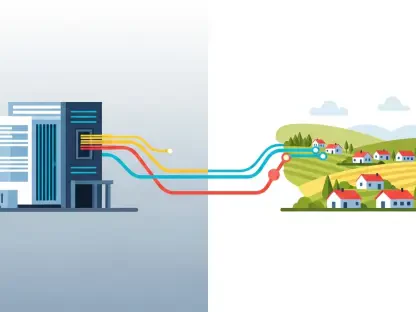The telecommunications sector stands at a crossroads, faced with the formidable task of adapting to the revolutionary forces of Artificial Intelligence (AI) and the implementation of 5G Standalone (5G SA) networks. As digital economies expand and connectivity demands escalate, telcos must reassess their role and redefine traditional models. The current framework, which predominantly focuses on internal network operations, requires a paradigm shift towards a service-oriented approach aimed at addressing the multifaceted requirements of contemporary connectivity. This transformation is vital for telcos to remain relevant and competitive, as highlighted by industry discussions, including those at the FutureNet World event in London. The sector must embrace these changes to navigate the digital evolution successfully and maintain its foothold in an increasingly complex technological landscape.
The Call for Reinvention
In pursuit of staying ahead, industry leaders advocate for a dramatic shift from conventional vertical, siloed operations toward more dynamic horizontal capabilities. Notables such as Colin Bannon of BT Business and Laurent Leboucher of Orange are at the forefront of this reinvention movement, emphasizing that service flexibility is the cornerstone of maintaining competitiveness. This transition demands that telcos evolve to become agile entities capable of keeping pace with the swift shifts in the digital economy. Artificial Intelligence is heralded as a key enabler in this journey, empowering companies to deliver differentiated quality services that exceed the mere provision of basic connectivity. By harnessing the power of AI, telcos can offer enhanced value propositions, ensuring high-quality service, which is quickly becoming a fundamental offering in today’s tech-driven market. The role of AI is pivotal, reshaping network operations to meet evolving user expectations and laying the groundwork for impactful changes in the industry.
Realizing 5G’s Promise
The promise embodied by 5G, especially its potential for delivering differentiated network services to enterprises, raises critical questions about its fulfillment. Industry discussions reveal a keen interest in understanding whether 5G’s anticipated benefits have materialized. Laurent Leboucher articulates the ongoing challenge of monetizing connectivity in transformative ways, despite the evident advantages it offers to enterprises. The proliferation of AI-generated traffic, characterized by both active content and logistical demands, urges a reevaluation of network requirements, pushing for deviation from traditional ‘best-approach’ models. Contrastingly, Jeanie York from Virgin Media O2 argues that the technical infrastructure for 5G SA is mostly established, shifting focus to adoption and monetization as the primary challenges. She emphasizes the undeniable potential for applications in areas like private manufacturing networks and enhanced events, recognizing AI’s fundamental role while underscoring the necessity for improved reliability and availability to fulfill enterprise demands more effectively.
Addressing the “Value Gap”
The notion of a “value gap,” introduced by Colin Bannon, highlights a pressing challenge within the telecommunications industry. This gap represents the mismatch between services offered by telcos and the perceived value received by their customers. Businesses often display heavy reliance on connectivity without sufficiently investing in service quality or resilience, exposing a systemic issue that demands attention. Bannon stresses the importance of reclaiming the narrative around service quality, particularly as telcos have been overshadowed by cloud providers in discussions of reliability and value. Trust and credibility become increasingly crucial against a backdrop of geopolitical concerns and national service obligations, requiring a shift in customer focus from cost considerations to an emphasis on quality, resiliency, and differentiation. This shift highlights the network’s strategic significance, opposing its perception as merely a utility, and points toward a broader understanding of connectivity as a cornerstone in achieving operational resilience.
Shifting Perceptions
Oleg Volpin from Amdocs reassures the current industry dialogue with a perspective that challenges outdated views of connectivity as a mere utility. He presents tangible examples, such as a power outage event in Spain, where the absence of network was felt more acutely than the loss of electricity, underscoring connectivity’s vital role in modern life. This underscores the need for telcos to focus on delivering reliable and robust networks, reflecting connectivity’s growing importance as digital demands rise. As industries and individuals increasingly rely on consistent connectivity, perceptions must evolve to acknowledge its strategic importance beyond superficial utility. Conversations around shaping perceptions are urged to center on presenting connectivity’s integral role, pushing for recognition of network services as essential components rather than ancillary offerings within the broader technological and economic landscape.
Overcoming Hurdles
To stay ahead in today’s rapidly evolving market, industry leaders call for a significant transition from traditional, vertically organized operations to more adaptable, horizontally-focused capabilities. Influential figures such as Colin Bannon from BT Business and Laurent Leboucher from Orange lead this movement, highlighting service flexibility as essential for retaining a competitive edge. Telcos are challenged to transform into agile organizations that can match the rapid developments of the digital economy. Artificial Intelligence stands out as a crucial facilitator in this evolution, enabling companies to offer unique quality services well beyond basic connectivity. By leveraging AI’s capabilities, telecommunications companies can deliver enhanced value propositions, ensuring superior services that are now vital in the technology-driven landscape. AI plays a critical role, revolutionizing network operations to meet changing user standards and setting the stage for substantial shifts in the sector, ultimately reshaping the industry landscape.









